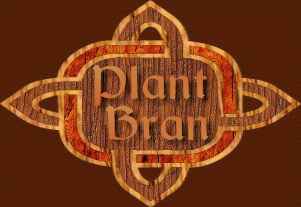
Samhain in Britain
By Brigid

In pre-Christian times, Samhain was the time of the year when everyone prepared for the winter by gathering in the harvests of grain, fruit, nuts, vegetables and of course animals.It marked the end of summer and the beginning of winter, and in those days it was a case of if one did not store food for this time, one did not eat!
The days were rapidly getting shorter and colder, and the sun's heat was noticeably diminished, and it was the beginning of a time when deaths were not uncommon. They thouight about their ancestors as spirits, who were able to visit at this time of year when it was said that the veil between this world and the Otherworld was thin enough to allow them passage through.
They lit bonfires and torches to strengthen the sun, and to purify the lands and the people, they feasted on all the bits of animal which couldn't be preserved, together with anything of which they had plenty; and they communed with their ancestors, telling stories about them and their exploits and relationships The ancestral spirits were not a source of fear, far from it, they were expected to return with messages and warnings, and these, together with the divinations of the local soothsayer, were avidly listened to and taken notice of. At this time too, they looked towards their descendants, those whom they knew would come, but knew they would not meet with them in the flesh.Food was left for the spirits, and it was considered fortuitous if some sign was left to show that they had 'partaken' of this food.
At some point, probably with more than a little help from the Christians,
the spirits became evil in the minds of the people, and instead of thinking of them as
'people' to be listened to, they lit their fires to keep them away! There was even real
fear of going outside on Samhain's Eve.
We know much of what the original Samhain celebrations had changed into by the mid
nineteenth century and into the present. Fires have continued to be lighted, in many
places and for many 'reasons', depending on the part of the country. Feasting, always
including apples and nuts, and various 'Party Games' have continued to be enjoyed.
Divination, though usually of a quite trivial nature with apple peel, nuts or stones, was
and is, carried on. Turnip lanterns impersonate the 'spirits', though neither children nor
adults realise this in most cases.
At one time, all over Europe, people left out offerings of food and drink, and lit candles for their ancestors, and this probabl;y eventually led to the tradition of 'Souling', when, first young men, and then later, children, would go round from house to house asking for 'Soul-cakes' and singing traditional songs. Remembering the departed was what it was all about, though again, to most of the participants it was just fun. There were also 'Guisers', folk who would go around and perform mumming plays, similar to those at Yuletide, and with the same mixture of altered and half-remembered words, but including no little reference to ghosts and spirits, and having at least one person draped in a white sheet!! Souling songs and Guising plays are still performed in a few areas of the country, and it can be expected that with the current interest in 'old tradition', there may well be revivals in other areas too.
And today? In a village with which I am familiar, picture this event. The celebrations have of course been moved to November 5th, and called Bonfire Night or Guy Fawkes Night check , but a bonfire is built, as it used to be. It is composed of anything for which the villagers have no further use, broken equipment, tree prunings, ancient furniture - just about anything which wil burn. The children carry lanterns made from hollowed out swedes (no pumpkins here!!) There is a firework display, after which they all go into the village hall for the feast. What do they eat? Sausages, stew, potatoes, parkin, toffee and apples. The sausages and stew contain meat which could not be preserved; the stew contains offerings from various farmers who have grown swedes, carrots etc. The ladies in the village cook potatoes (also donated by the farmers) in their skins and bring them to the hall. Everyone talks to everyone else; those who have not met socially for a long time get caught up on family news, and tell stories about what has happened to them during the year. After the feast, people wander to the fire, and can be seen quietly gazing into it What are they seeing? Pictures? Do these pictures mean anything to them?
Isn't this familiar? The bonfire and fireworks to send help to the declining sun, the feast, the stories, divination in the fire, and the mutual support and co-operation. We still hold parties, where we bob for apples, roast chestnuts, tell ghost stories and sing the old songs. Food and wine is left on the hearth for our unseen kinsfolk, past present or future!
No, Samhain isn't dead, it is just sleeping.
![]()


